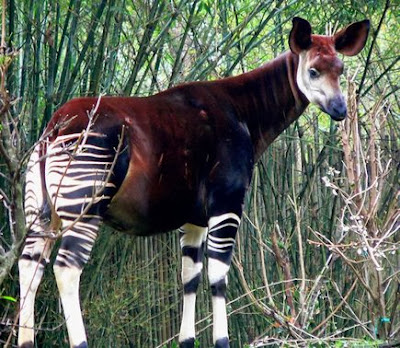 |
| Zebra, Donkey & Young Zonkey |
A zebroid (also zedonk, zorse, zebra mule, zonkey, and zebrule) is the offspring of any cross between a zebra and any other horses: essentially, a zebra hybrid. In most cases, the father is a zebra stallion. Offspring of a donkey father and zebra mother, called a zebra hinny, or donkra, do exist but are rare. Zebroids have been bred since the 19th century. Charles Darwin noted several zebra hybrids. A crossbreed zebra is known as a zebroid or zebra mule. Zebroids were originally breed as pack animals in Africa for practical reasons. They are more resistant
to certain diseases, such as sleeping sickness, than horses or donkeys. Zebroids for domestic use are breed for the look of zebra, tempered by the domesticated nature of horse or donkey. The crossbreed is often shaped like the non-zebra parent, which makes finding proper saddle simpler than trying to ride a zebra. Zebra stripes tend to show up on at least part of hybrid's body.
to certain diseases, such as sleeping sickness, than horses or donkeys. Zebroids for domestic use are breed for the look of zebra, tempered by the domesticated nature of horse or donkey. The crossbreed is often shaped like the non-zebra parent, which makes finding proper saddle simpler than trying to ride a zebra. Zebra stripes tend to show up on at least part of hybrid's body.
 |
| Okapi |
Okapi:
A zony is the offspring of a zebra stallion and a pony mare. Medium-sized pony mares are preferred to produce riding zonies, but zebras have been crossed with smaller pony breeds such as the Shetland, resulting in so-called "Zetlands". This animal looks like a cross between a zebra and a giraffe! But it's more of a red herring here. The okapi is an African rainforest relative of the giraffe that just happens to have zebra-striped legs. Although known to locals, the okapi was considered a mythical animal among Europeans until it was classified in the 20th century. Okapis are neither descended from nor related to zebras.
A zony is the offspring of a zebra stallion and a pony mare. Medium-sized pony mares are preferred to produce riding zonies, but zebras have been crossed with smaller pony breeds such as the Shetland, resulting in so-called "Zetlands". This animal looks like a cross between a zebra and a giraffe! But it's more of a red herring here. The okapi is an African rainforest relative of the giraffe that just happens to have zebra-striped legs. Although known to locals, the okapi was considered a mythical animal among Europeans until it was classified in the 20th century. Okapis are neither descended from nor related to zebras.
 |
| Zorse |
Genetics:
Donkeys and wild equids have different numbers of chromosomes. A donkey has 62 chromosomes; the zebra has between 32 and 46 (depending on species). In spite of this difference, viable hybrids are possible, provided the gene combination in the hybrid allows for embryonic growth to birth. A hybrid has a number of chromosomes somewhere in between. The chromosome difference makes female hybrids poorly fertile and male hybrids generally sterile due to a phenomenon called Haldane's Rule. The difference in chromosome number is most likely due to horses having two longer chromosomes that contain similar gene content to four zebra chromosomes. Horses have 64 chromosomes, while most zebroids end up with 54 chromosomes. Common wisdom states that hybrids only occur when the zebra is the father, but the Barbados hybrid demonstrates otherwise. Two other known zebra hinnies have been foaled, but did not survive to adulthood. The rarity of zebra hinnies indicates the smaller number of chromosomes must generally be on the male side if a viable hybrid is to be produced. Before this comes into account, a successful mating needs to be completed in the first place. As courtship in horses includes the mare kicking at the stallion's head for some time before allowing him to mount, and as this behavior is stronger in wild equids than in domestic horses, it is difficult enough to get a horse stallion to mate and not be put off by the rough behavior of the non-horse mare.
 |
| Zorse |
CHARACTERISTICS:
Zebroids physically resemble their nonzebra parent, but are striped like a zebra. The stripes generally do not cover the whole body, and might be confined to the legs or spread onto parts of the body or neck. If the nonzebra parent was patterned, such as a roan, Appaloosa, Pinto horse/paint, piebald, or skewbald, this pattern might be passed down to the zebroid, in which case the stripes are usually confined to nonwhite areas. Zorses combine the zebra striping overlaid on colored areas of the hybrid's coat. Zorses are most often bred using solid color horses. If the horse parent is piebald (black and white) or skewbald (other color and white), the zorse may inherit the dominant depigmentation genes for white patches. Zebroids are preferred over zebra for practical uses, such as riding, because the zebra has a different body shape from a horse or donkey, and consequently it is difficult to find tack to fit a zebra. However, a zebroid is usually more inclined to be temperamental than a purebreed horse and can be difficult to handle. Zebras, being wild animals, and not domesticated like horses and donkeys, pass on their wild animal traits to their offspring. Zebras, while not usually very large, are extremely strong and aggressive. Similarly, zorses have a strong temperament and can be aggressive.
No comments:
Post a Comment